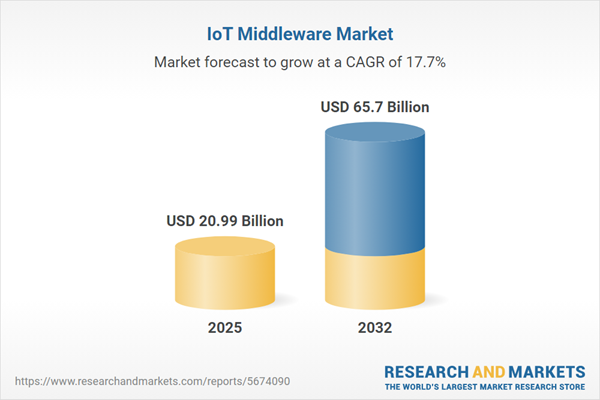Speak directly to the analyst to clarify any post sales queries you may have.
The IoT middleware market is rapidly transforming the digital landscape for enterprises, offering critical integration, security, and data management capabilities amid rising technological complexity and regulatory shifts. This report delivers a focused analysis tailored to senior decision-makers, providing actionable insights for capitalizing on middleware opportunities while managing operational and regulatory risk.
Market Snapshot: IoT Middleware Market Size and Growth
The IoT Middleware Market grew from USD 17.80 billion in 2024 to USD 20.99 billion in 2025. It is expected to continue growing at a CAGR of 17.73%, reaching USD 65.70 billion by 2032. Forward momentum is supported by enterprise initiatives in digital transformation, with middleware emerging as the pivotal layer orchestrating device connectivity, secure data routing, and real-time analytics across diverse sectors.
Scope & Segmentation: In-Depth View of the IoT Middleware Landscape
This comprehensive report evaluates global trends and opportunities, providing detailed analysis and forecasts across major market segments, solution offerings, technologies, and geographic regions.
- Component Types: Analytics (Predictive, Prescriptive, Real-Time), Application Enablement (API Management, Workflow Orchestration), Connectivity Management (LoRaWAN, NBIoT, Sigfox), Data Management (Big Data Integration, Edge Processing, Time-Series Processing), Device Management (Firmware Management, Provisioning), Security (Authentication, Compliance, Encryption)
- Deployment Models: Cloud (Private, Public), Hybrid (Multi-Cloud Integration), On-Premises (Private Data Centers)
- Connectivity Technologies: Bluetooth (BLE, Classic), Cellular (3G, 4G LTE, 5G), LPWAN (LoRaWAN, NBIoT, Sigfox), Wi-Fi (Wi-Fi 5, Wi-Fi 6)
- Industry Verticals: Energy & Utilities (Asset Management, Smart Grid), Healthcare (Patient Monitoring, Remote Diagnostics), Manufacturing (Automotive, Electronics, Process Manufacturing), Retail (Customer Engagement, In-Store Analytics), Transportation (Fleet Management, Logistics, Public Transport)
- Organization Sizes: Large Enterprises (Tier 1, Tier 2), SMEs (Medium, Micro, Small)
- Application Types: Asset Tracking, Energy Management, Fleet Management, Monitoring & Diagnostics, Predictive Maintenance, Real-Time Analytics, Security Management
- Geographical Coverage: Americas (North America: US, Canada, Mexico; Latin America: Brazil, Argentina, Chile, Colombia, Peru), Europe, Middle East & Africa (Europe: UK, Germany, France, Russia, Italy, Spain, Netherlands, Sweden, Poland, Switzerland; Middle East: UAE, Saudi Arabia, Qatar, Turkey, Israel; Africa: South Africa, Nigeria, Egypt, Kenya), Asia-Pacific (China, India, Japan, Australia, South Korea, Indonesia, Thailand, Malaysia, Singapore, Taiwan)
- Leading Companies: Amazon.com, Inc., Microsoft Corporation, International Business Machines Corporation, Google LLC, PTC Inc., Cisco Systems, Inc., Software AG, Siemens AG, Bosch Software Innovations GmbH, Huawei Technologies Co., Ltd.
Key Takeaways for Senior Decision-Makers
- Middleware is fundamental in connecting disparate IoT devices, enabling real-time data flow and automation within distributed environments.
- Shifts to edge computing and embedded AI are streamlining data processing and powering more responsive, autonomous systems.
- Strategic partnerships between platforms, telecom operators, and cloud providers are accelerating deployment capabilities and fostering new service models.
- Security and compliance features are increasingly built into solutions to address emerging regulatory demands and sophisticated cyber risks.
- Flexible, modular middleware supports adaption to diverse industry requirements and facilitates smooth integration with legacy and next-generation systems.
- Regional trends, such as rapid digitalization in Asia-Pacific and regulatory drivers in Europe, are shaping the adoption pace and technology selection across markets.
Tariff Impact: Navigating New Supply Chain Challenges
Recent tariffs introduced in the United States in 2025 have had a pronounced effect on the sourcing and pricing of IoT middleware hardware components. These trade measures have increased vendor production costs, prompting a reassessment of supply chain strategies, vendor partnerships, and manufacturing footprints. Enterprises are responding through regional sourcing, strategic inventory management, and a greater focus on on-premises and hybrid deployments to mitigate tariff-related risks and ensure business continuity.
Market Methodology & Data Sources
The report applies a mixed-methods approach, uniting primary data gathered from executive interviews with secondary analysis of industry reports and financial disclosures. A structured triangulation process validates insights and ensures objectivity, with peer reviews from domain specialists and case studies from multiple sectors for enhanced relevance.
Why This Report Matters for Your IoT Middleware Strategy
- Offers a complete, fact-based framework to help guide technology investments and maximize operational agility.
- Equips leaders to anticipate regulatory, technological, and competitive shifts across global and regional markets.
- Supports risk-informed sourcing and partnership decisions for resilient and future-ready IoT middleware strategies.
Conclusion
IoT middleware stands at the nexus of digital transformation, enabling secure, scalable, and intelligent operations. This report offers essential guidance for organizations seeking to harness middleware in driving growth, resilience, and competitive edge in a fast-evolving landscape.
Additional Product Information:
- Purchase of this report includes 1 year online access with quarterly updates.
- This report can be updated on request. Please contact our Customer Experience team using the Ask a Question widget on our website.
Table of Contents
3. Executive Summary
4. Market Overview
7. Cumulative Impact of Artificial Intelligence 2025
Companies Mentioned
The companies profiled in this IoT Middleware market report include:- Amazon.com, Inc.
- Microsoft Corporation
- International Business Machines Corporation
- Google LLC
- PTC Inc.
- Cisco Systems, Inc.
- Software AG
- Siemens AG
- Bosch Software Innovations GmbH
- Huawei Technologies Co., Ltd.
Table Information
| Report Attribute | Details |
|---|---|
| No. of Pages | 187 |
| Published | November 2025 |
| Forecast Period | 2025 - 2032 |
| Estimated Market Value ( USD | $ 20.99 Billion |
| Forecasted Market Value ( USD | $ 65.7 Billion |
| Compound Annual Growth Rate | 17.7% |
| Regions Covered | Global |
| No. of Companies Mentioned | 11 |









